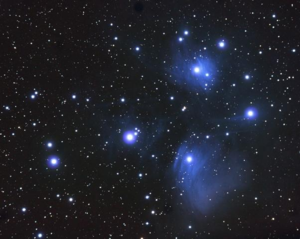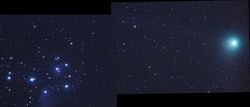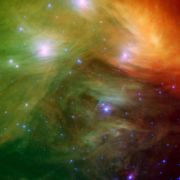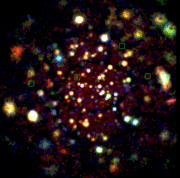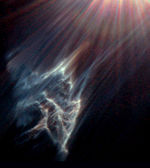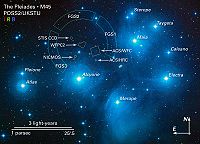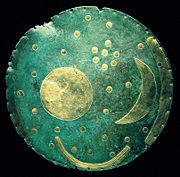Pleiades
2008/9 Schools Wikipedia Selection. Related subjects: Space (Astronomy)
| Pleiades | |
 A colour-composite image of the Pleiades from the Digitized Sky Survey. Credit: NASA/ESA/ AURA/ Caltech. |
|
| Observation data ( J2000 epoch) | |
|---|---|
| Constellation | Taurus |
| Right ascension | 3h 47m 24s |
| Declination | +24° 7′ |
| Distance | 440 ly (135 pc) |
| Other designations | M45, Seven Sisters |
| See also: Open cluster, List of open clusters | |
The Pleiades (pronounced /ˈpliːədiːz/ or /ˈplaɪədiːz/), also known as M45, the Seven Sisters, Seven Stars, SED, Matariki (New Zealand), or Subaru (Japan), is an open cluster in the constellation of Taurus. It is among the nearest star clusters, and is probably the best known, and is certainly the most obvious to the naked eye. It is sometimes referred to as the Maia Nebula, perhaps erroneously considering that the reflection nebulosity surrounding Maia is intrinsic (see below).
The cluster is dominated by hot blue stars which have formed within the last 100 million years. Dust that forms a faint reflection nebulosity around the brightest stars was thought at first to be left over from the formation of the cluster, but is now known to be an unrelated dust cloud that the stars are currently passing through. Astronomers estimate that the cluster will survive for about another 250 million years, after which it will have dispersed due to gravitational interactions with its galactic neighbourhood.
Observational history
The Pleiades are a prominent sight in winter in the Northern Hemisphere and in summer in the Southern Hemisphere, and have been known since antiquity to cultures all around the world, including the Māori and Australian Aborigines, the Chinese, the Maya (who called them Tzab-ek), the Aztec and the Sioux of North America. Some Greek astronomers considered them to be a distinct constellation, and they are mentioned by Hesiod, and in Homer's Iliad and Odyssey. They are also mentioned three times in the Bible ( Job 9:9, 38:31; Amos 5:8). The Pleiades ( Krittika) are particularly revered in Hindu mythology as the six mothers of the war god Skanda, who developed six faces, one for each of them. Some scholars of Islam suggested that the Pleiades (At-thuraiya) are the Star in Najm which is mentioned in the Quran.
They have long been known to be a physically related group of stars rather than any chance alignment. The Reverend John Michell calculated in 1767 that the probability of a chance alignment of so many bright stars was only 1 in 500,000, and so correctly surmised that the Pleiades and many other clusters of stars must be physically related. When studies were first made of the stars' proper motions, it was found that they are all moving in the same direction across the sky, at the same rate, further demonstrating that they were related.
Charles Messier measured the position of the cluster and included it as M45 in his catalogue of comet-like objects, published in 1771. Along with the Orion Nebula and the Praesepe cluster, Messier's inclusion of the Pleiades has been noted as curious, as most of Messier's objects were much fainter and more easily confused with comets—something which seems scarcely possible for the Pleiades. One possibility is that Messier simply wanted to have a larger catalogue than his scientific rival Lacaille, whose 1755 catalogue contained 42 objects, and so he added some bright, well-known objects to boost his list.
Distance
The distance to the Pleiades is an important first step in the so-called cosmic distance ladder, a sequence of distance scales for the whole universe. The size of this first step calibrates the whole ladder, and the scale of this first step has been estimated by many methods. As the cluster is so close to the Earth, its distance is relatively easy to measure. Accurate knowledge of the distance allows astronomers to plot a Hertzsprung-Russell diagram for the cluster which, when compared to those plotted for clusters whose distance is not known, allows their distances to be estimated. Other methods can then extend the distance scale from open clusters to galaxies and clusters of galaxies, and a cosmic distance ladder can be constructed. Ultimately astronomers' understanding of the age and future evolution of the universe is influenced by their knowledge of the distance to the Pleiades.
Results prior to the launch of the Hipparcos satellite generally found that the Pleiades were about 135 parsecs away from Earth. Hipparcos caused consternation among astronomers by finding a distance of only 118 parsecs by measuring the parallax of stars in the cluster—a technique which should yield the most direct and accurate results. Later work has consistently found that the Hipparcos distance measurement for the Pleiades was in error, but it is not yet known why the error occurred. The distance to the Pleiades is currently thought to be the higher value of about 135 parsecs (roughly 440 light years).
Composition
The cluster core radius is about 8 light-years and tidal radius is about 43 light years. The cluster contains over 1000 statistically confirmed members, although this figure excludes unresolved binary stars. It is dominated by young, hot blue stars, up to 14 of which can be seen with the naked eye depending on local observing conditions. The arrangement of the brightest stars is somewhat similar to Ursa Major and Ursa Minor. The total mass contained in the cluster is estimated to be about 800 solar masses.
The cluster contains many brown dwarfs, which are objects with less than about 8% of the Sun's mass, not heavy enough for nuclear fusion reactions to start in their cores and become proper stars. They may constitute up to 25% of the total population of the cluster, although they contribute less than 2% of the total mass. Astronomers have made great efforts to find and analyse brown dwarfs in the Pleiades and other young clusters, because they are still relatively bright and observable, while brown dwarfs in older clusters have faded and are much more difficult to study.
Also present in the cluster are several white dwarfs. Given the young age of the cluster normal stars are not expected to have had time to evolve into white dwarfs, a process which normally takes several billion years. It is believed that, rather than being individual low- to intermediate-mass stars, the progenitors of the white dwarfs must have been high-mass stars in binary systems. Transfer of mass from the higher-mass star to its companion during its rapid evolution would result in a much quicker route to the formation of a white dwarf, although the details of this supposed transfer from a deeper gravity well to a lesser are unexplained.
Age and future evolution
Ages for star clusters can be estimated by comparing the Hertzsprung-Russell diagram for the cluster with theoretical models of stellar evolution, and using this technique, ages for the Pleiades of between 75 and 150 million years have been estimated. The spread in estimated ages is a result of uncertainties in stellar evolution models. In particular, models including a phenomenon known as convective overshoot, in which a convective zone within a star penetrates an otherwise non-convective zone, result in higher apparent ages.
Another way of estimating the age of the cluster is by looking at the lowest-mass objects. In normal main sequence stars, lithium is rapidly destroyed in nuclear fusion reactions, but brown dwarfs can retain their lithium. Due to lithium's very low ignition temperature of 2.5 million kelvins, the highest-mass brown dwarfs will burn it eventually, and so determining the highest mass of brown dwarfs still containing lithium in the cluster can give an idea of its age. Applying this technique to the Pleiades gives an age of about 115 million years.
The cluster's relative motion will eventually lead it to be located, as seen from Earth many millennia in the future, passing below the feet of what is currently the constellation of Orion. Also, like most open clusters, the Pleiades will not stay gravitationally bound forever, as some component stars will be ejected after close encounters and others will be stripped by tidal gravitational fields. Calculations suggest that the cluster will take about 250 million years to disperse, with gravitational interactions with giant molecular clouds and the spiral arms of the galaxy also hastening its demise.
Reflection nebulosity
Under ideal observing conditions, some hint of nebulosity may be seen around the cluster, and this shows up in long-exposure photographs. It is a reflection nebula, caused by dust reflecting the blue light of the hot, young stars.
It was formerly thought that the dust was left over from the formation of the cluster, but at the age of about 100 million years generally accepted for the cluster, almost all the dust originally present would have been dispersed by radiation pressure. Instead, it seems that the cluster is simply passing through a particularly dusty region of the interstellar medium.
Studies show that the dust responsible for the nebulosity is not uniformly distributed, but is concentrated mainly in two layers along the line of sight to the cluster. These layers may have been formed by deceleration due to radiation pressure as the dust has moved towards the stars.
Names and technical information
The nine brightest stars of the Pleiades are named for the Seven Sisters of Greek mythology: Sterope, Merope, Electra, Maia, Taygete, Celaeno and Alcyone, along with their parents Atlas and Pleione. As daughters of Atlas, the Hyades were sisters of the Pleiades. The English name of the cluster itself is of Greek origin, though of uncertain etymology. Suggested derivations include: from πλεîν plein, to sail, making the Pleiades the "sailing ones"; from pleos, full or many; or from peleiades, flock of doves. The following table gives details of the brightest stars in the cluster:
| Name | Pronunciation ( IPA & respelling) | Designation | Apparent magnitude | Stellar classification |
|---|---|---|---|---|
| Alcyone | /ælˈsaɪəni/, al-sye'-ə-nee | Eta (25) Tauri | 2.86 | B7IIIe |
| Atlas | /ˈætləs/, at'-ləs | 27 Tauri | 3.62 | B8III |
| Electra | /iːˈlɛktrə/, ee-lek'-trə | 17 Tauri | 3.70 | B6IIIe |
| Maia | /ˈmeɪə, ˈmaɪə/; may'-ə, mye'-ə | 20 Tauri | 3.86 | B7III |
| Merope | /ˈmɛrəpi/, mair'-ə-pee | 23 Tauri | 4.17 | B6IVev |
| Taygeta | /teɪˈɪʤətə/, tay-ij'-ə-tə | 19 Tauri | 4.29 | B6V |
| Pleione | /ˈplaɪəni/, plye'-ə-nee | 28 (BU) Tauri | 5.09 (var.) | B8IVep |
| Celaeno | /s |
16 Tauri | 5.44 | B7IV |
| Asterope | /əˈstɛrəpi/, ə-stair'-ə-pee | 21 and 22 Tauri | 5.64;6.41 | B8Ve/B9V |
| — | — | 18 Tauri | 5.65 | B8V |
In folklore and literature
| “ | Δέδυκε μεν ἀ σελάννα καὶ Πληΐαδεσ, μέσαι δὲ νύκτεσ πάρα δ᾽ ἔρχετ᾽ ὤρα, ἔγω δὲ μόνα κατεύδω. The Moon is set, And the Pleiades. Night's half gone, Time's passing. I sleep alone now. |
” |
|
— Sappho
|
| “ | Can you bind the beautiful Pleiades? Can you loose the cords of Orion? |
” |
|
— Job 38:31
|
| “ | Many a night I saw the Pleiads, rising thro' the mellow shade, Glitter like a swarm of fireflies tangled in a silver braid. |
” |
|
— Alfred Tennyson, Locksley Hall
|
| “ | Can I get two maybe even three of these, Comin' from a space to teach you of the Pleiades. |
” |
|
— Red Hot Chili Peppers, " Can't Stop"
|
| “ | Though all I knew of a rote universe were those Pleiades loosed in December, I promised you I'd set them to verse so I'd always remember. |
” |
|
— Joanna Newsom, "Emily"
|
| “ | Last night I saw the Pleiades again, Faint as a drift of steam From some tall chimney-stack; |
” |
|
— Arthur Adams, "The Pleiades"
|
The Pleiades' high visibility in the night sky has guaranteed it a special place in many cultures, both ancient and modern. In Greek mythology, they represented the Seven Sisters, while to the Vikings, they were Freyja's hens, and their name in many old European languages compares them to a hen with chicks.
To the Bronze Age people of Europe, such as the Celts (and probably considerably earlier), the Pleiades were associated with mourning and with funerals, since at that time in history, on the cross-quarter day between the autumn equinox and the winter solstice (see Samhain, also Halloween or All Souls Day), which was a festival devoted to the remembrance of the dead, the cluster rose in the eastern sky as the sun's light faded in the evening. It was from this acronychal rising that the Pleiades became associated with tears and mourning. As a result of precession over the centuries, the Pleiades no longer marked the festival, but the association has nevertheless persisted, and accounts for the significance of the Pleiades astrologically.
The early Monte Alto Culture and others in Guatemala such as Ujuxte and Takalik Abaj, made its early observatories, using the Pleiades and Eta Draconis as reference, they were called the seven sisters, and thought to be their original land.
Heliacal risings very often mark important calendar points for ancient peoples. The heliacal rising of the Pleiades (around June) also begins the new year for the Māori of New Zealand, who call the Pleiades Matariki. There is an analogous holiday in Hawaiʻi known as Makaliʻi. The ancient Aztecs of Mexico and Central America based their calendar upon the Pleiades. Their calendric year began when priests first remarked the asterism rising heliacally in the east, immediately before the sun's dawn light obliterated the view of the stars. Aztecs called the Pleiades Tianquiztli (meaning "marketplace").
Indigenous Australians and Mainland Asians
Depending on the tribe or clan, there are several stories regarding the origins of the Pleiades. Some Indigenous Australian peoples believed the Pleiades was a woman who had been nearly raped by Kidili, the man in the moon.
Another version, often painted by Gabriella Possum Nungurayyi as this is her dreaming (or creation story), daughter of the late Clifford Possum Tjapaltjarri from the Central desert art movement of Papunya, depicts the story of seven Napaltjarri sisters being chased by a man named Jilbi Tjakamarra. He tried to practice love magic to one of the sisters but the sister did not want to be with him and with her sisters, they ran away from him. They sat down at Uluru to search for honey ants but when they saw Jilbi, they went to Kurlunyalimpa and with the spirits of Uluru, transformed into stars. Jilbi transforms himself into what is commonly known as the Morning Star in Orion's belt, thus continuing to chase the seven sisters across the sky.
Among the Ban Raji, who live in semi-nomadic settlements scattered throughout western Nepal and northern India, the Pleiades are called the "Seven sisters-in-law and one brother-in-law" (Hatai halyou daa salla). Ban Rajis note that when the Pleiades rises up over the mountain each night, they feel happy to see their ancient kin (Fortier 2008:in press). On a more practical note, Ban Rajis can tell that evening has arrived, indicating that it is about eight o’clock by local time standards when their star-kin rise above the Nepali mountains bordering the Kali River.
Native Americans
The Lakota Tribe of North America had a legend that linked the origin of the Pleiades to Devils Tower. According to the Seris (of northwestern Mexico), these stars are seven women who are giving birth. The constellation is known as Cmaamc, which is apparently an archaic plural of the noun cmaam "woman".
It was common among the indigenous peoples of the Americas to measure keenness of vision by the number of stars the viewer could see in the Pleiades, a practice which was also used in historical Europe, especially in Greece.
The Native American tribe, the Kiowa, had a myth similar to the Lakota that explained the creation of the Pleiades. According to the Kiowa there were seven young maidens that went out to play and were spotted by several giant bears. The bears saw the young women and began to chase them. In an effort to escape the bears the women climbed on top of a rock and prayed to the spirit of the rock to save them. Hearing their prayers the rock began to rise from the ground towards the Heavens so that the bears couldn't reach the maidens. The seven women reached the sky and were then turned into the star constellation we know today. The bears in an effort to climb the rock left deep claw marks in the sides which had become too steep to climb. The rock later became known as Devil's Tower which is located in the state of Wyoming.
In the ancient Andes, the Pleiades were associated with abundance, because they return to the Southern Hemisphere sky each year at harvest-time. In Quechua they are called collca', or storehouse.
Paul Goble, Native American storyteller, tells a Blackfoot legend that he says is told by other tribes as well. In the story, the Pleiades are orphans that were not cared for by the people, so they became stars. Sun Man is angered by the mistreatment of the children and punishes the people with a drought, until the dogs, the only friends of the orphans, intercede on behalf of the people.
The American Hopi Indians built their underground Kivas for multiple utilitarian uses. The most important of which was their ceremonial meeting place. The access was a ladder through a small hole in the roof of the round hole in the ground. During certain ceremonies, the night passage of the Pleiades over the centre of the opening of the entrance hole was a direct signal to begin a certain ceremony. Most of the cultures used the angle of the Pleiades in the night sky as a time telling device.
Ukrainian
In Ukrainian traditional folklore the Pleiades are known as Стожари (Stozhary), Волосожари (Volosozhary), or Баби-Звізди (Baby-Zvizdy).
'Stozhary' can be etymologically traced to "стожарня" (stozharnya) meaning a 'granary', 'storehouse for hay and crops', or can also be reduced to the root "сто-жар", (sto-zhar) meaning 'hundredfold glowing'. ..
'Volosozhary' (the ones whose hair is glowing), or 'Baby-Zvizdy' (female-stars) refer to the female tribal deities. Accordingly to the legend, seven maids lived long ago. They used to dance the traditional round dances and sing the glorious songs to honour the gods. After their death the gods turned them into water nymphs, and, having taken them to the Heavens, settled them upon the seven stars, where they dance their round dances (symbolic for moving the time) to this day. (see article in Ukrainian Wikipedia)
In Ukraine this asterism was considered a female talisman until recent times.
